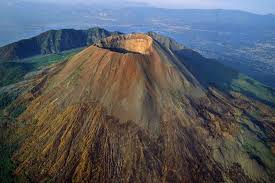Mount Vesuvius:

A mechanical artwork created in 1775 to portray the eruption of Italy’s Mount Vesuvius has been recently brought to life for the first time.
- Mount Vesuvius is an active volcano located on the west coast of Italy near Naples, in the Gulf of Naples.
- It stands about 4,200 feet (1,280 meters) high, but its height changes after each major eruption.
- It is a composite stratovolcano, made up of pyroclastic flows, lava flows, and debris from lahars that accumulated to form the volcanic cone.
- A high ridge known as Mount Somma partly surrounds the main cone of Vesuvius.
- The area between the ridge and the cone is known as Valle del Gigante (Giant’s Valley).
- At the top of the cone is a large crater. It is about 1,000 feet (300 meters) deep and 2,000 feet (600 meters) across.
- As part of the Campanian volcanic arc, it formed over the subduction zone created by the collision of the Eurasian and African tectonic plates.
- This subduction zone stretches the length of the Italian peninsula and is the source of other volcanoes, such as Etna and Stromboli.
- Mount Vesuvius is the only active volcano in mainland Europe.
- Its eruptions typically involve explosive eruptions as well as pyroclastic flows.
- It is one of the most dangerous volcanoes on the planet.
- It is most famous for the 79 AD eruption, which destroyed the Roman cities of Pompeii and Herculaneum.
- The cities were engulfed in pyroclastic flows—superheated, high-density clouds of volcanic gas, ash, and rock that flow downslope at hundreds of kilometers per hour.
- The last major eruption occurred in 1944.




